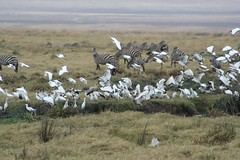
Click on pic to see slideshow
or here to access the Ngorongoro set
Shaking and growling, the vehicle trudges its way up on the bumpy dirt road to the rim of the crater. The “Crater access road” sign, scribbled with red paint on a wooden board appears out of the morning fog for a brief moment. It is an unassuming but unambiguous signal that we are about to cross to the other side of the mirror into wonderland, and like Alice in the fable, I am curious, excited and a little anxious. What if the experience doesn’t live up to the expectations? But there isn’t much time for wondering and questioning. We are turning sharp corners going downhill now, on the steep track clumsily carved in the mountainside. This isn’t much of a road – it’s riddled with holes and boulders, uneven and dusty - but a real road – god forbid, paved! – would be completely out of place in the Ngorongoro crater anyway.
Nearly five hours later we emerge from the caldera at another point. The fog has broken long ago; now a different sign greets us in plain sight – “Crated ascent road. Do not enter.” Yes, I want to say. Do not enter; leave this place alone, you can only ruin it. I am transfigured by the experience and selfishly I’d like to be the last pair of eyes to admire the wonders down below. Any more visitors after me could only bring destruction and waste to this still-perfect world; more gas fumes from their jeeps, more roads and more plastic bottles will eventually topple the fragile natural balance that keeps the crater alive and unmistakably magical … But I am just being childish: no plastic bottles littler the crater floor, and while many 4x4 vehicles hit the crater roads every day loaded with trigger-happy tourists who take shots until their memory cards are full, the visitor impact is kept to a minimum and the animals seem undisturbed by human presence.
I was elated. On the way back to camp I was pondering silently if I could truthfully and honestly say that I have never seen a place more beautiful than the Ngorongoro crater. This was the single moment that redeemed all the disappointments of the whole 6-week overland trip. Bad and incompetent guides, sitting in the truck for hours each day, some uninteresting and annoying tour partners, the waking up before sunrise almost every day – none of that mattered anymore: this trip had fulfilled its purpose, it has made me happy. Luckily, the visit to the crater happened on the last day of the trip – had we gone the other way, Ngorongoro would have been our first stop, and later I would have compared all other game parks with it, probably to their disadvantage. My expectations had been sky-high, ever since I had read a beautifully illustrated National Geographic article about the crater lions, which had interbred for so long without bringing in new blood from outside, that they displayed a string of genetic defects and had become vulnerable to diseases otherwise benign to lions. My expectations of this place were sky-high – but they were met and exceeded.
Sadly, during the visit we didn’t get any information from the guides about the crater, its animal populations and the conservation challenges. Our local “guide” and driver didn’t speak to us at all (although he spoke English) for the whole duration of the game drive – but he often blabbered in Swahili on the radio with the other drivers, and talked to our Kenyan tour guide, who was too busy making out on the back seat with the Swiss girl in our group to be of any help. Nevertheless I didn’t mind; the nature did the talking for them. But I’m not sure if the guide realized that if he had been more helpful, I would have gladly left him a tip at the end.
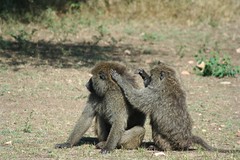
Click on pic to see slideshow
or here to access the Serengeti set

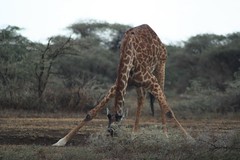
My memory of these days is dominated by the fantastic moments spent in the crater. But a day prior to that game drive we had visited another wildlife reserve, further to the west of Tanzania: the Serengeti. It is quite possibly the most famous national park in the world, a name instantly recognizable as a symbol of wildlife abundance. You say Serengeti and your mind immediately pictures lions hunting gazelles, buffaloes wallowing in the mud, a parade of elephants lingering among the trees in the evening sun, and millions of wildebeest stampeding the plain, turning the horizon into a black cloud. There was none of that. Besides an abundance of Thompson gazelles and zebras, the other animals were scarce; there was not one single elephant in sight. I can’t say I was disappointed – the scenery was beautiful, with the high, green and yellow grasses on the gently sloping hills, the lush marshes teeming with hippos along the quiet river and the eerie rock formations rising out of the immense plain. Some animals finally showed up and posed for our cameras, but I was left with a tinge of dissatisfaction – maybe my expectations had been too high and when that mental image of a pride of roaring lions bringing down a struggling buffalo had failed to materialize I refused to see the beauty of what actually was around me. Sometimes I have to remind myself that eyes are most useful when kept open.
Fast facts: The Ngorongoro Conservation Area is situated 180km west of Arusha in the Tanzanian highlands. Its main feature is the Ngorongoro crater, formed after a volcanic explosion some 2 million years ago. The crated floor is 610m deep and covers 260 square kilometers. It boasts one of the highest concentration of wildlife in Africa and is home to most species found in East Africa, including the "big five" (lion, leopard, rhinoceros, elephant and buffalo). The crater's steep walls form a natural migration barrier, keeping most animals permanently inside.
Published from Alexandria, Egypt. Still catching up...



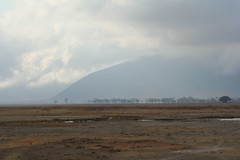
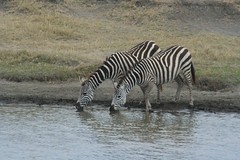

5 comments:
Whilst this article is quite accurate, it does not adequately reflect the majesty of Tanzania (and Kenya)or the friendly attitude of the indignous people.
I can only assume that the writer had a one off bad experience with the tour guide, as for the driver constantly talking to other drivers over the radio, this is quite normal they keep in touch with each other and share information as to where the game is so that the tourists can get the best out of their trip.
I fully concur with the above comment and equally appreciate the fairly accurate descriptions of the writer of the article not to mention his lucid style, picturesque details and simple, but beautiful expressions and versatility. Quite enjoyable.
His failure to secure a good guide book - and there are plenty to choose from- might have contributed to some of his disappointments or even lack of knowledge about certain facts both for Ngorongoro and Serengeti. A visit to a good bookshop, even in his own home country, could have saved him from such vicissitudes and deficiencies. He could have also learnt, for instance, that giraffes are nowhere to be seen inside the crater and why. Yet quite a few to be seen on the rim of the curator. Why?
Similarly, all Africsn animals and birds, small and big, are readily available in the Serengeti, but one would have to know where their territories are or be led to such locations by a well experienced tour guide, within this absolutely vast area of Serengeti. Its enormous size means one or two days are just not enough to cover even one 1 percent of its majestic size.
A sufficiently well organised and well prepared journey, specifically concentrated to Serengeti would produce a fair and accurate description of its diverse and rich contents equal to and in certain aspects superior to those of the Ngorongoro. I cannot wait to read such similar lucid description by the same writer to Serengeti. Marvellous writer!
Ebby Shareef
Ebby, thanks for the words of appreciation.
I did have quite a few guidebooks with me (I traveled around the world and I was well prepared for every destination). But through my travels I learned that a good conversation with a well-informed guide creates a much more enjoyable experience.
Beside, guides can give first-hand information and recount anecdotes which, even if not 100% factual, make for a very pleasurable ride nonetheless.
That snag didn't spoil my trip; the crater was too fantastic a place and just being there was enough. It could have been better, though.
hello, yup totally agree, the crator was amazing, truly like another world. It really opens your eyes to everything.
i liked the serengetti aswell though, but we must have been lucky, as we saw lots there aswell but i guess its just timing.
glad you enjoyed yourself though.
so how did you find travelling the world? How did you go about it?
Having Lived in Tanzania for two years and visited several of the national parks, I fully agree with the writer's comments that Ngorongoro is the star of all. It encompassed an amazing veriety of different eco-systems within its 25km radius - grasslands, swamp, rivers, acidic lake, freshwater lakes, bushland, wooded forest, mountain... an amzing microcosm.
Arguably it is a host to a wide variety and high density of herbivore and carnivore fauna. None of these residents have any reason to leave this place of abundance. As a tourist destination it is well managed and ecofriendly but very pricey. A good tourist guide is indeed a huge asset, especially from a big company with many cars in the crater, as they can communicate the location of herds and prides on radio for everybody's benefit.
The writers probably visited Serengeti at the wrong time. The best time to visit is Early May and August, the time of the 'Grand Migration' (to North and to South respectively) when the there are more animals to see than trees. The best part is to see the massive groups of wildebeests and zebras crossing the River Grumeti in Serengeti when they cross en-masse in groups of 1000s. This is also the bi annual feast time for the huge crocodile population of Grumeti. Early may is also a good time as this is winter time in Tanzania and animals stay out in the open sun for longer. I have witnesses large herds of 20-25 elephants - including baby elephants - grazing in Serengeti. The tougher to sight are usually the cheeta, the leopard and the rhino as they are usually shy and stay away from the tourist tracks.
Hippo lovers should visit the hippo pools early morning around daybreak. This is the only time they can be seen walking and usually get back underwater after sunrise and only their rounded back can be seen protruding out of the water.
Post a Comment